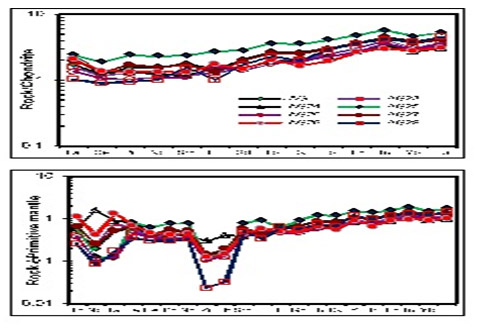Basic Science
| Title | Geochemistry and Platinum Group Element systematics from Singhbhum craton |
|---|---|
| Participants | Manikyamba, C., Jyotisankar Ray, M. Satyanarayanan, Adrija Chatterjee, Abhishek Saha, Mutum Rajanikanta Singh, Sohini Ganguly, A. Keshav Krishna, K.S.V. Subramanyam, D. Purushotham, S. Sawant |
| Sponsoring Agency | DST |
Work Description:
The Older Metamorphic Group (OMG) of Singhbhum craton is the oldest Group (>3200 Ma) consisting of ortho and para amphibolites, pelitic schists, arenites, calc-silicates, mafic and ultramafic rocks. The ultramafic enclave has uniformly higher MgO and lower SiO2 (30.58 – 32.91 and 42-46.7 wt.% respectively) whereas the mafic rocks have 3.9-10.2 wt.% and 45.4-50.7 wt.% MgO and SiO2 respectively. The ferromagnesian trace elements also show consistent depletion from ultramafic to mafic composition. The Ni and Cr contents of the ultramafic rocks range from 492-1335 and 2404-4385 ppm whereas the mafic rocks show 191-291 and 667-1031 ppm indicating a much evolved chemical composition. The major and trace element composition has also reflected in their REE behavior. The ultramafic rocks have much depleted total REE (3.82-8.92 ppm) in comparison with the enriched mafic counterparts (14.5 – 29.01 ppm). The ultramafic rocks exhibit LREE depletion with variable degrees of HREE enrichment and exhibit negative Ce anomaly with positive to negative Eu anomaly (Fig. 17.1). The mafic rocks have flat REE patterns with positive to negative Ce and negligible Eu anomalies. Both mafic and ultramafic rocks have consistent troughs at Nb-Ta and Zr-Hf with low order negative Ti anomalies. Positive Ta anomalies are observed in few ultramafic rocks. The ultramafic rocks have higher platinum group elements (PGE) than their mafic counterparts (ΣPGE=9.2-41.8 and 9.9-27.4 ppm respectively). The major, trace and rare earth elemental compositions along with PGE systematics indicate that the ultramafics derived from higher degrees (30-45%) melting of a spinel peridotite source in the temperature regime of 1450-15000C where garnet entered into the melt; whereas the mafic rocks derived through fractional crystallization of the ultramafic melt
The IOG lavas from the Noamundi and Dangoaposi areas and dykes from Gajpur and Thakurani Pahad are porphyritic basalts with phenocrysts of plagioclase and clinopyroxene (major) and orthopyroxene (minor) embedded in a find grained cryptocrystalline groundmass. The lavas are tholeiitic (SiO2= 47.95-53.75 wt. % and Al2O3= 12.73-14.41 wt. %) with mafic to intermediate compositions (MgO= 6.35-15.54 wt. %) having a total alkali content varying from 1.1 -5.61 wt. %. They have variable concentrations of ferromagnesian trace elements (Ni=43-251 ppm; Cr=47-649 ppm), Zr (12-90 ppm) and total REE (28-145 ppm) and exhibit flat to slightly fractionated REE patterns with negative Eu anomalies (except one sample). Few samples have negative Nb, Zr and Hf anomalies whereas the others exhibit positive Ta anomalies. The Gajpur and Thakurani Pahad dykes intruded into IOG lavas are uniformly tholeiitic in composition with moderate MgO (7.4-13.3 wt. %) and total alkali (3.3-3.9wt.%) contents. These dykes have 41-112 ppm Ni, 28-244 ppm Cr, 34-781 ppm Zr and 61-144 ppm total rare earth element compositions. The dykes from both the areas exhibit slightly fractionated patterns with negative Eu. All the analysed dykes have negative Nb and positive Ta anomalies. Few of them exhibit positive anomalies at U, Zr and Hf whereas the others show distinct Zr-Hf troughs. The IOG lavas and dykes are extremely depleted in PGE and show a S-saturated character. The geochemical systematics indicates that the IOG lavas are products of variable degrees of partial melting and fractional crystallization of a depleted mantle source. PGE depletion in the analyzed samples supports the depleted mantle source for the origin of these rocks. The geochemical signatures of the dykes and the IOG lavas suggest their derivation in different melting events from a common depleted mantle source.
 Fig.17.1:
Fig.17.1:
Rare earth element and trace element Systematic of ultramafic enclaves from Older Metamorphic Group (OMG) of Singhbhum craton